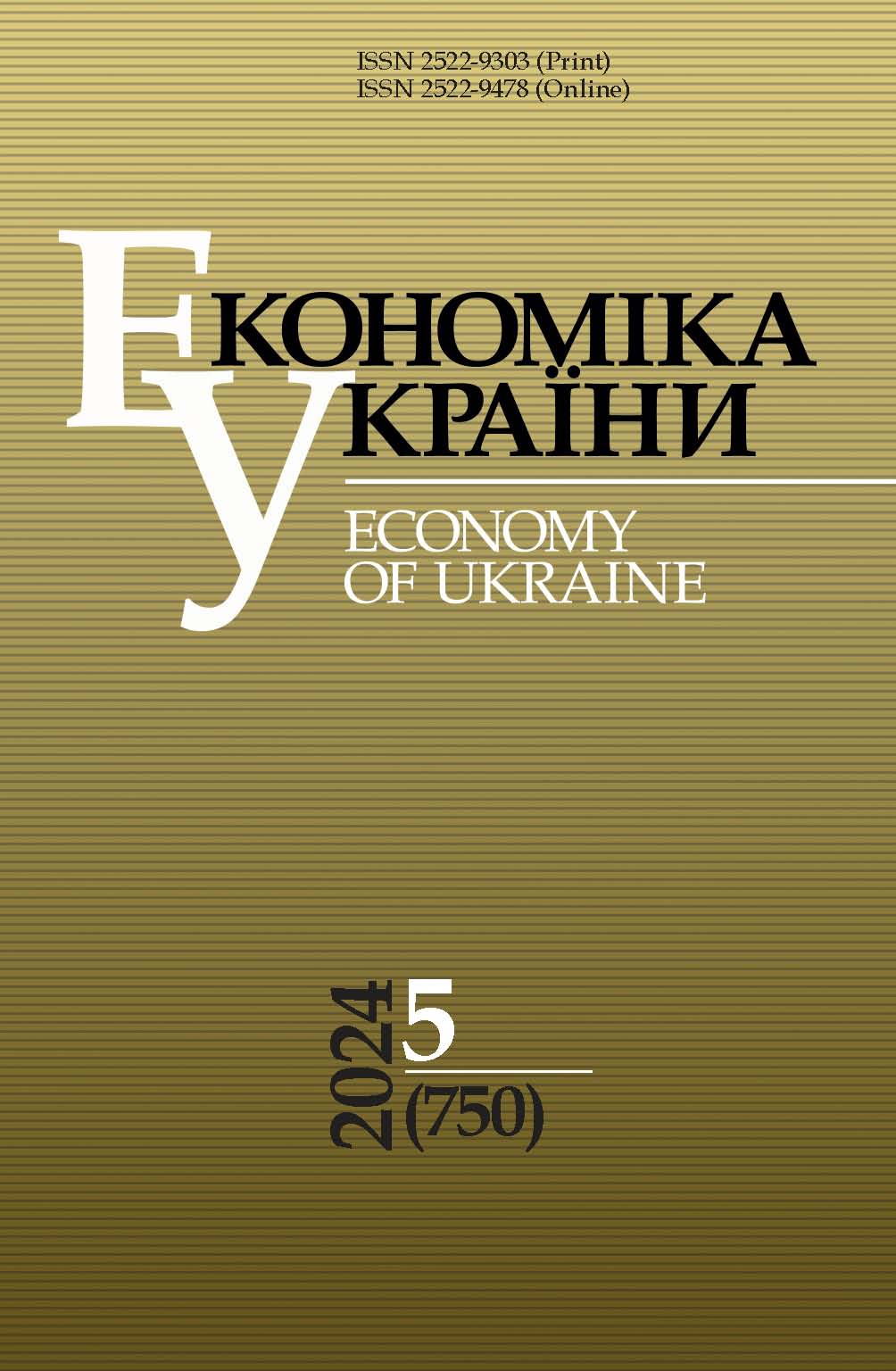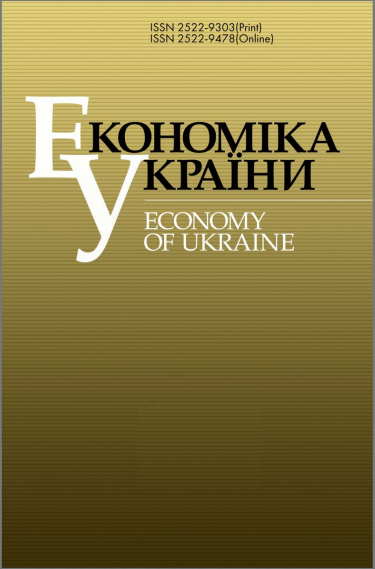CULTURAL CAPITAL: ESSENCE AND REALIZATION MECHANISMS UNDER THE ORANGE ECONOMY
DOI:
https://doi.org/10.15407/economyukr.2024.05.003Keywords:
cultural capital; intangible assets; cultural and creative industries; experience economy; orange economyAbstract
The concept of cultural capital is explored, its functions, features and realization mechanisms are identified. Cultural capital is defined as an objectified and incorporated cultural resource involved in economic circulation in the form of tangible and intangible cultural assets with a high potential for self-reproduction, accumulation and conversion into other forms of capital.
Based on the formed functional characteristics of cultural capital, it is proposed to prioritize and single out cultural capital as a separate object of conversion and transaction within the new experience economy, or, more precisely, the orange economy, since such semantic demarcation can have a positive effect, manifested in a more complete and more effective use of the potential of cultural capital. The main methodical approaches to the assessment of cultural capital, in particular, as an intangible asset, are presented and analyzed.
The categorical basis of the orange economy is expanded, its relationship with the intangible economy, creative economy and creative industries is defined, its place and role in the overall structure of the new economy are shown. It is proven that the main difference between the creative economy and the traditional economic structure is that the main tool in it is knowledge, the main resource is information, and the main product is innovation, that is, the concept of the creative economy unites such scientific fields as digital economy, knowledge economy and innovation economy. The orange economy is defined as an "umbrella" term due to its summarizing nature, since it encompasses the activities that take place within the creative economy, cultural industries and cultural sectors, as well as the experience, knowledge and innovation economy.
Emphasis is placed on significant potential of cultural industries in the post-war reconstruction of Ukraine, due to the rise of the spirit of national idea, the increase in demand for domestic cultural products and the demand of the population (as well as foreign consumers) for unique, authentic Ukrainian cultural artifacts.
References
Harrison, L. (2012). Jews, Confucians, and Protestants: Cultural Capital and the End of Multiculturalism. 230 p. URL: https://books.google.pt/books?id=Rbqn4RfUMioC&printsec=frontcover&hl=ru#v=onepage&q&f=false
Bourdieu, P. (2002). Forms of Capital. In: The Sociology of Economic Life. M. Granovetter, R. Swedberg (Eds). 2nd ed. Boulder, Westview Press. P. 96-111. https://doi.org/10.1002/9780470755679.ch15
Yaish, M., Katz-Gerro, T. (2010). Disentangling «Cultural Capital»: The Consequences of Cultural and Economic Resources for Taste and Participation. European Sociological Review. Vol. 5. P. 1-17. https://doi.org/10.1093/esr/jcq056
Saltelli, A., Kuc-Czarnecka, M., Lo Piano, S., Lőrincz, M., Olczyk, M., Puy, A., Reinert, E. et al. (2023). Impact assessment culture in the European Union. Time for something new? Environmental Science and Policy. Vol. 142. P. 99-111. https://doi.org/10.1016/j.envsci.2023.02.005
Markowska, B. (2018). Cultural capital as analytical category: between economy and culture. Zoon Politikon. Special Issue. P. 133-155. https://doi.org/10.4467/2543408XZOP.18.007.10063
Milano, C. (2023). Democratization or vulgarization of cultural capital? The role of social networks in theater’s audience behavior. ENCATC Journal of Cultural Management and Policy. Vol. 4. Iss. 1. P. 46-56. https://doi.org/10.3389/ejcmp.2023.v4iss1-article-5
Horyachuk, V. (2012). Conceptual model of broad understanding of capital. Efficient Economy. Vol. 3. URL: http://nbuv.gov.ua/UJRN/efek_2012_3_14 [in Ukrainian].
Glevarec, H. (2022). From Cultural Capital to Knowledge. Review of the substantial and cognitive uses of an arbitrary social relationship. HAL open science. 43 p. URL: https://hal.science/hal-03627939v1/document
Zugravu, N., Kafrouni, R., Bouard, S., Apithy, L. (2021). Do cultural capital and social capital matter for economic performance? An empirical investigation of tribal agriculture in New Caledonia. Ecological Economics. Vol. 182, 106933. https://doi.org/10.1016/j.ecolecon.2020.106933
Borre, J., Romero, G., Gutiérrez, J., Ramírez, J. (2023). Discussion of the aspects of the cultural and creative industries that impact on sustainable development: a systematic review. Procedia Computer Science. Vol. 224. P. 532-537. https://doi.org/10.1016/j.procs.2023.09.077
Drobakhina, T. (2022). Creative industries as an object of public administration: approaches to research and typology. Dnipro Scientific Journal of Public Administration, Psychology, Law. Vol. 4. P. 203-209. https://doi.org/10.51547/ppp.dp.ua/2022.4.31 [in Ukrainian].
Moore, I. (2014). Cultural and Creative Industries Concept – a Historical Perspective. Procedia – Social and Behavioral Sciences. Vol. 110. P. 738-746. https://doi.org/10.1016/j.sbspro.2013.12.918
Tomczyk, M., Wojtkiewicz, M. (2016). Business Model of Culture and Creative Industries Incubator in creating social innovation. In: The Role of Cultural Institutions and Events in the Marketing of Cities and Regions. T. Domański (Ed.). Łódź. P. 191-201. http://dx.doi.org/10.18778/8088-149-5.12
Bedate, A., Herrero, L., Sanz, J. (2004). Economic valuation of the cultural heritage: application to four case studies in Spain. Journal of Cultural Heritage. Vol. 5. Iss. 1. P. 101-111. https://doi.org/10.1016/j.culher.2003.04.002
Necissa, Y. (2011). Cultural heritage as a resource: its role in the sustainability of urban developments. The Case of Tlemcen, Algeria. Procedia Engineering. Vol. 21. P. 874-882. https://doi.org/10.1016/j.proeng.2011.11.2089
Bratchuk, L. (2015). Economic essence of intellectual capital and its accounting assistance. Economic Analysis. Vol. 21. No. 2. P. 262-269. URL: http://nbuv.gov.ua/UJRN/ecan_2015_21%282%29__40 [in Ukrainian].
Sobko, O. (2016). Intellectual capital and creation of enterprise value. Ternopil. 444 p. URL: http://dspace.wunu.edu.ua/jspui/handle/316497/22515 [in Ukrainian].
Illyasenko, S., Holysheva, Ye., Kolodka, A. (2017). Management of intellectual capital of the enterprise. Sumy. 360 p. URL: https://essuir.sumdu.edu.ua/handle/123456789/58874 [in Ukrainian].
Ghiasi, M. (2015). The Role of Culture Components in Growth and Economic Development Process of Countries. Specialty Journal of Accounting and Economics. Vol. 1. Iss. 1. P. 6-10. URL: https://sciarena.com/article/the-role-of-culture-components-in-growth-and-economic-development-process-of-countries
Boroszewski, J., Nowak-Posadzy, K. (2021). Economic Models as Cultural Artifacts: A Philosophical Primer. Filozofia Nauki. Vol. 29. Iss. 3. P. 63-87. https://doi.org/10.14394/filnau.2021.0016
Weckroth, M., Kemppainen, T. (2016). Human capital, cultural values and economic performance in European regions. Regional Studies, Regional Science. Vol. 3. Iss. 1. P. 239-257. https://doi.org/10.1080/21681376.2016.1177467
Yong, E. (2019). Understanding cultural diversity and economic prosperity in Europe: a literature review and proposal of a culture – economy framework. Asian Journal of German and European Studies. Vol. 4. Article No. 5. https://doi.org/10.1186/s40856-019-0043-3
Cerisola, S., Panzera, E. (2021). Cultural and Creative Cities and Regional Economic Efficiency: Context Conditions as Catalyzers of Cultural Vibrancy and Creative Economy. Sustainability. Vol. 13, 7150. P. 1-23. https://doi.org/10.3390/su13137150
Guiso, L., Sapienza, P., Zingales, L. (2006). Does Culture Affect Economic Outcomes? Journal of Economic Perspectives. Vol. 20. No. 2. P. 23-48. https://doi.org/10.1257/jep.20.2.23
Karimzadi, S. (2019). Culture in Economics. Advances in Economics and Business. Vol. 7. Iss. 1. P. 39-54. https://doi.org/10.13189/aeb.2019.070105
Ramocka, M. (2010). Culture as an economic growth factor. Zeszyty Naukowe Małopolskiej Wyższej Szkoły Ekonomicznej w Tarnowie. No. 2(16). P. 117-123. URL: https://bibliotekanauki.pl/articles/415054
Ramazanov, S., Tishkov, B., Honcharenko, O., Hostryk, A. (2022). A cognitive approach to modeling sustainable development of complex technogenic systems in the innovation economy. In: The 10th International Conference on Monitoring, Modeling & Management of Emergent Economy. CEUR Workshop Proceedings. Vol. 3465. P. 222-235. URL: http://www.scopus.com/inward/record.url?eid=2-s2.0-85171141287&partnerID=MN8TOARS
Ferreiro-Seoane, F., Llorca-Ponce, A., Rius-Sorolla, G. (2022). Measuring the Sustainability of the Orange Economy. Sustainability. Vol. 14. Iss. 6. 3400. https://doi.org/10.3390/su14063400
Khytra, O. (2022). Tourist branding in the conditions of the experience economy. Economy and Society, (42). https://doi.org/10.32782/2524-0072/2022-42-64 [in Ukrainian].
Nazarova, G., Sotnikova, Y. (2018). Creative Economy and Management: textbook. Kharkiv, S. Kuznets KhNUE. 160 p. URL: http://repository.hneu.edu.ua/handle/123456789/19943
Kaleniuk, I., Kuznetsova, N. (2022). Creative Economy in the Global Innovation Process. International economic policy. No. 1(36). P. 101-123. https://doi.org/10.33111/iep.2022.36.05 [in Ukrainian].
Dyshkantiuk, O. (2016). Economy of impressions - current stage of development of social production. Food Industry Economics. Vol. 8. No. 4. P. 3-9. URL: http://nbuv.gov.ua/UJRN/echp_2016_8_4_2 [in Ukrainian].
Boiarska, M. (2016). The essence and definition of the experience economy at the present stage of development of economy of Ukraine. Young Scientist. No. 4. P. 25-27. URL: http://repository.hneu.edu.ua/handle/123456789/13156 [in Ukrainian].
Ushkarenko, Iu., Chmut, A., Syniakova, K. (2018). Creative economy: the essence of the concept and the significance for Ukraine under the European integration. Economy and Society, (18). P. 67-72. https://doi.org/10.32782/2524-0072/2018-18-10 [in Ukrainian].
Khumarova, N. (Ed.) (2021). Experience economy and environmental management: principles of inclusiveness and sustainability. Odesa. 506 p. https://doi.org/10.31520/978-966-02-9838-5 [in Ukrainian].
Canaan, R. (2019). Creative Economy and Cultural Heritage: A Proposal to Tourism Development and Appreciation of Local Identity. Strategic Design Research Journal. Vol. 12. Iss. 2. P. 276-288. https://doi.org/10.4013/sdrj.2019.122.12
Lyck, L. (2013). Innovation and «Creative Economy». The 6th International Conference on Baltic Sea Parliamentary Cooperation (Berlin, 23–25 May, 2023). P. 1-10. URL: https://research.cbs.dk/en/publications/innovation-and-creative-economy
Shevchenko, L., Hrytsenko, O., Kaminska, T. et al. (2014). Intangible economy: managing the formation and use of intellectual capital. Kharkiv. 404 p. URL: https://dspace.nlu.edu.ua/handle/123456789/12375 [in Ukrainian].
Gruzdova, T. (2011). Definition and evaluation of intangible assets (of objects of intellectual property). Ukrainian Society. No. 3. P. 99-112. URL: http://nbuv.gov.ua/UJRN/Usoc_2011_3_10 [in Ukrainian].
Dyba, V. (2016). Methodological basis for estimation of intangible assets of corporation. Investment: Practice and Experience. No. 13. P. 23-28. URL: http://www.investplan.com.ua/?op=1&z=5071&i=3 [in Ukrainian].
Plekan, M. (2015). Problematic aspects of intangible assets. Scientific Bulletin of Uzhhorod University. Vol. 1(2). P. 112-115. URL: http://nbuv.gov.ua/UJRN/Nvuuec_2015_1%282%29__26 [in Ukrainian].
Yanishivskiy, V. (2010). Methodical approaches to integral estimation of intellectual capital of region. Demography and social economy. No. 2(14). P. 16-25. URL: https://dse.org.ua/arhcive/14.html [in Ukrainian].
Popyk, O. (2021). Economic essence of the «semantic capital» category. Scientific Bulletin of the Odesa National Economic University. Vol. 5-6. P. 65-69. https://doi.org/10.32680/2409-9260-2021-5-6-282-283-65-69 [in Ukrainian].
Borovik, Y., Elagin, Y., Polyakova, E. (2020). Green economy: essence, principles, prospects for Ukraine. The bulletin of transport and industry economics. No. 69. P. 75-83. URL: http://nbuv.gov.ua/UJRN/Vetp_2020_69_10 [in Ukrainian].
Mishenin, Ye., Koblianska, I. (2020). Sustainable development action program: review of green, blue and circular economics concepts. Visnyk of Sumy State University. Economy. No. 3. P. 247-257. URL: http://nbuv.gov.ua/UJRN/VSU_ekon_2020_3_29 [in Ukrainian].
Yevtushenko, O., Arsenkina, D. (2022). Possibilities of post-war economic recovery using creative industries. The Journal of V. N. Karazin Kharkiv National University. Series: "International Relations. Economics. Country Studies. Tourism", (16). 64-74. https://doi.org/10.26565/2310-9513-2022-16-07 [in Ukrainian].
Downloads
Published
How to Cite
Issue
Section
License
Copyright (c) 2024 Publisher PH "Academperiodyka" of the NAS of Ukraine

This work is licensed under a Creative Commons Attribution-NonCommercial-NoDerivatives 4.0 International License.



